Portrait Mode: Artist Henry Taylor Finally Gets His Due
I'm sitting in the artist Henry Taylor's driveway in early summer, watching him rough out a portrait in his home garage-slash-studio. He works quickly, applying pink to large areas of the canvas, then counterbalancing with generous slathers of a lush green, pausing only occasionally to search for the next song on his iPhone. Kanye's album Ye just dropped, and I'm lobbying for “Ghost Town” while Taylor's on the hunt for the Psychedelic Furs' “Pretty in Pink,” in homage to the canvas's dominant hue. Once he lays out one of his subject's basic forms, he goes to work approximating a face. Some of the details in a Taylor portrait are close to what you or I might see, while others—the signature Taylor strokes—are far more impressionistic. Energetically, he's all over the place, pushing in tight to examine his canvas or make a mark, then stepping back again. It's never about finishing one specific part; it's always about the whole picture. Every so often, Taylor steps back and snaps a photo, like he's taking a note. Throughout the process, the sun continuously shifts in the sky, giving it all a fleeting race-against-time intensity.
This being my third interview session with Taylor, I'm hell-bent on reining him in conversationally. Especially because he's leaving tomorrow to teach at the prestigious Skowhegan summer residency in Maine. I need to get some clarity on our previous two conversations, but every response the artist gives is a wonderful impromptu, somersaulting bebop solo, even more diffuse than one by Charlie Parker—we're talking full-on Rahsaan Roland Kirk. So far, Taylor's pedal-to-metal stream of consciousness has me reaching for a slide rule every time I get home and start going through my notes.
To be clear, Taylor is completely open—he'll discuss anything—but every question is like a slingshot that sends him hurtling back through his past. It seems that painting, or rather the process of Henry Taylor talking about how or why he paints, is seamlessly interwoven with any number of autobiographical strands. Here's a fragment from his eighth-grade days, back in Oxnard, California. And here's an anecdote from one of his seven elder siblings. And here, for good measure, is an extended riff on a newspaper headline he scanned the morning he started a particular painting. “It's an old habit from when I studied journalism,” Taylor says, straightening an American Spirit between his fingers. “To this day, I can't put down a paper until I've turned every page.”
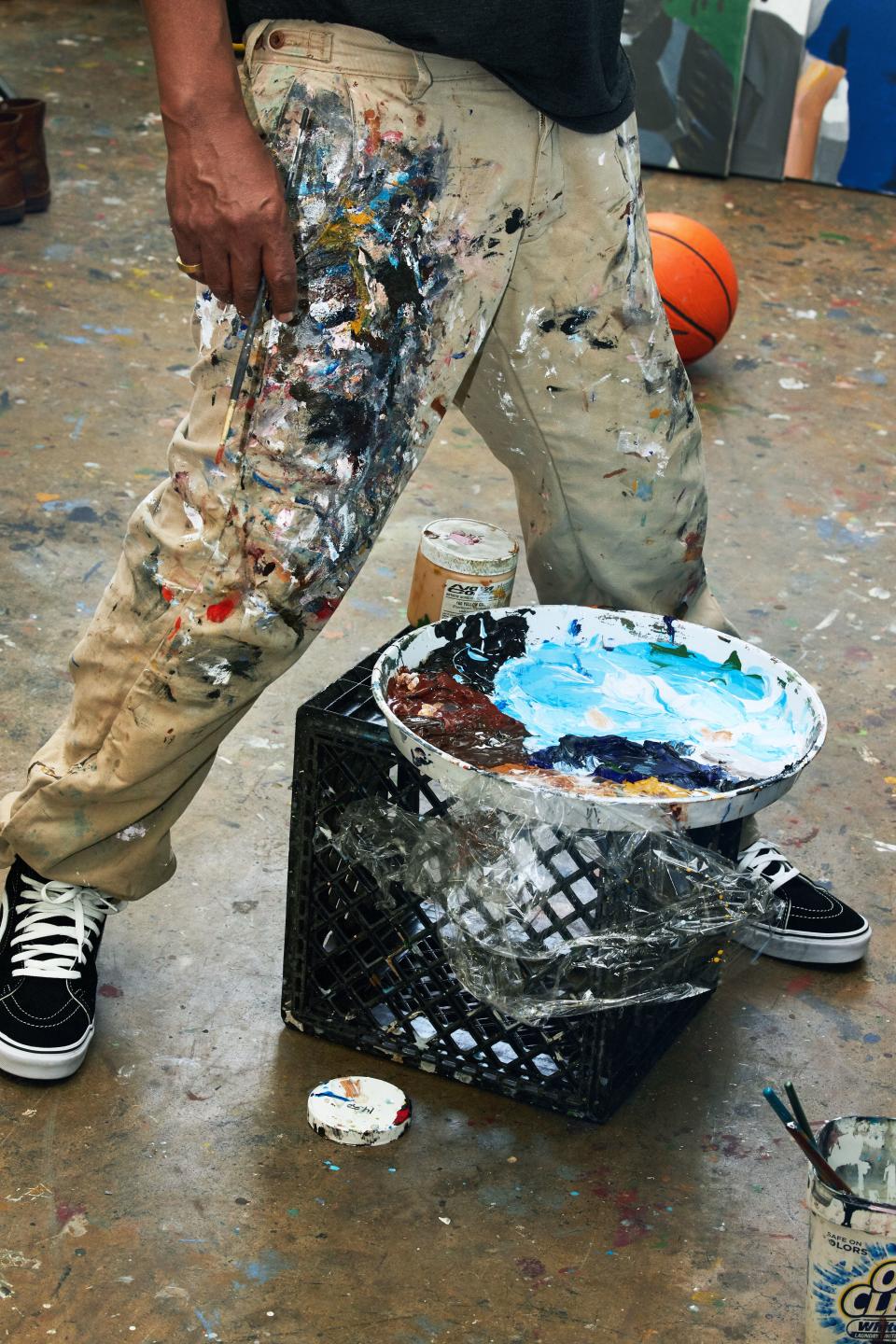
Along with journalism, Taylor studied interior design, which might help explain his gift for composition—the way he arranges the room of a given canvas. He confesses that design was a psychological backup in the days before he fully surrendered to chasing his true passion, fine art. Since he threw caution aside, Taylor has amassed a staggering body of work—mostly paintings but also sculpture and film. His bombastic and highly personal iconography is mostly rooted in portraiture of everyday people, some of whom he knows intimately. Friends, family, acquaintances, and strangers are occasionally peppered with relevant historical or pop-cultural figures, all characters in the narrative of Taylor's own vast life experience. For instance: A painting of Jackie Robinson stealing home playfully pokes at Taylor being a black artist in a predominantly white gallery world. A large canvas of Cicely Tyson and Miles Davis on the lawn in front of the White House on their way to visit the Obamas chronicles a more optimistic imaginary moment in the ebb and flow of the American Dream. A film unfolds as an ode to a long-ago moment the artist once shared with Bob Marley.
“Let somebody else do Obama,” Taylor says now. “I'd be much more likely to paint Al Green or, say, Sly Stone. The portraits have to hit me. Sometimes they go fast; other times you're just kind of thinking. Like the saying goes: You try hard, you die hard. I remember this one time, I got stuck painting my brother's dog for a week. I just had to get it right.” Tim Blum, whose gallery, Blum & Poe, is set to launch a much anticipated new Taylor show in New York this September, says in regard to Taylor's increasingly famous portraits, “The successful ones seem the most effortless. It's either coming or it's not. It's what he sees and how he paints it. If you're in the studio with him, it might not necessarily be what you see. It's a much deeper, truer place.”
“I just kept doing what I was doing, but wasn’t ever desperate or thirsty about it.”
As Taylor begins his seventh decade on the planet, his road has been a long and winding proposition. By the time he finished high school, his experiences included the removal of a benign brain tumor, a brother's tour in Vietnam, and another brother's suffering of severe burns. Then a ten-year stint working at California's Camarillo State Hospital while raising a son and at the same time entering the undergrad program at CalArts as a freshman in his early 30s. There was also a period that Taylor spent as a Rastafarian in Oakland, going by another name. Taylor's reminiscences about growing up have strains of Dickens or Faulkner. He watched from a bedroom window as his father and one of his brothers—both named Hershel—traded punches with the police in the front yard. He learned some sign language to more deftly cheat on school exams. In junior high, it was an art teacher with a yen for astrology, Teresa Escareno, who took an early interest in Taylor's trajectory. “She did my chart and told me that I was going to make it,” he says. “But that it wasn't going to happen right away. For some reason, I just believed her! That carried me for years. I was always patient, just kept doing what I was doing, but wasn't ever desperate or thirsty about it.”
Turns out, Mrs. Escareno's esoteric vision couldn't have been more on the money. Taylor is currently showing extensively throughout the world. He's already done solo exhibitions at the Studio Museum of Harlem and MoMA's PS1. He's been included in pedigree group shows like the Whitney Biennial and the Hammer Museum's Made in L.A. Adding to his canon, this fall Taylor's dropping a monograph with Rizzoli, a distinction often regarded as an art-critical rite of passage.
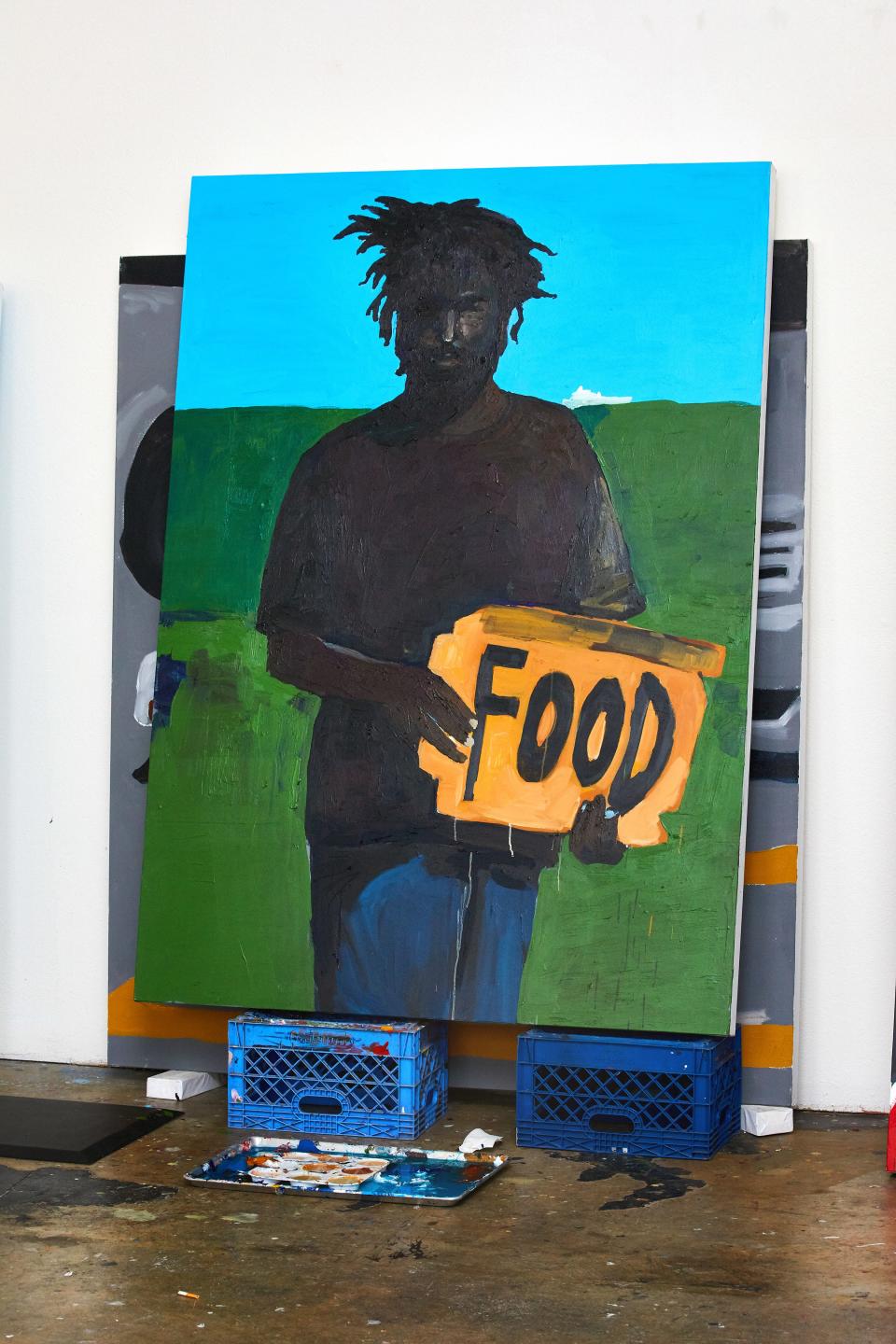
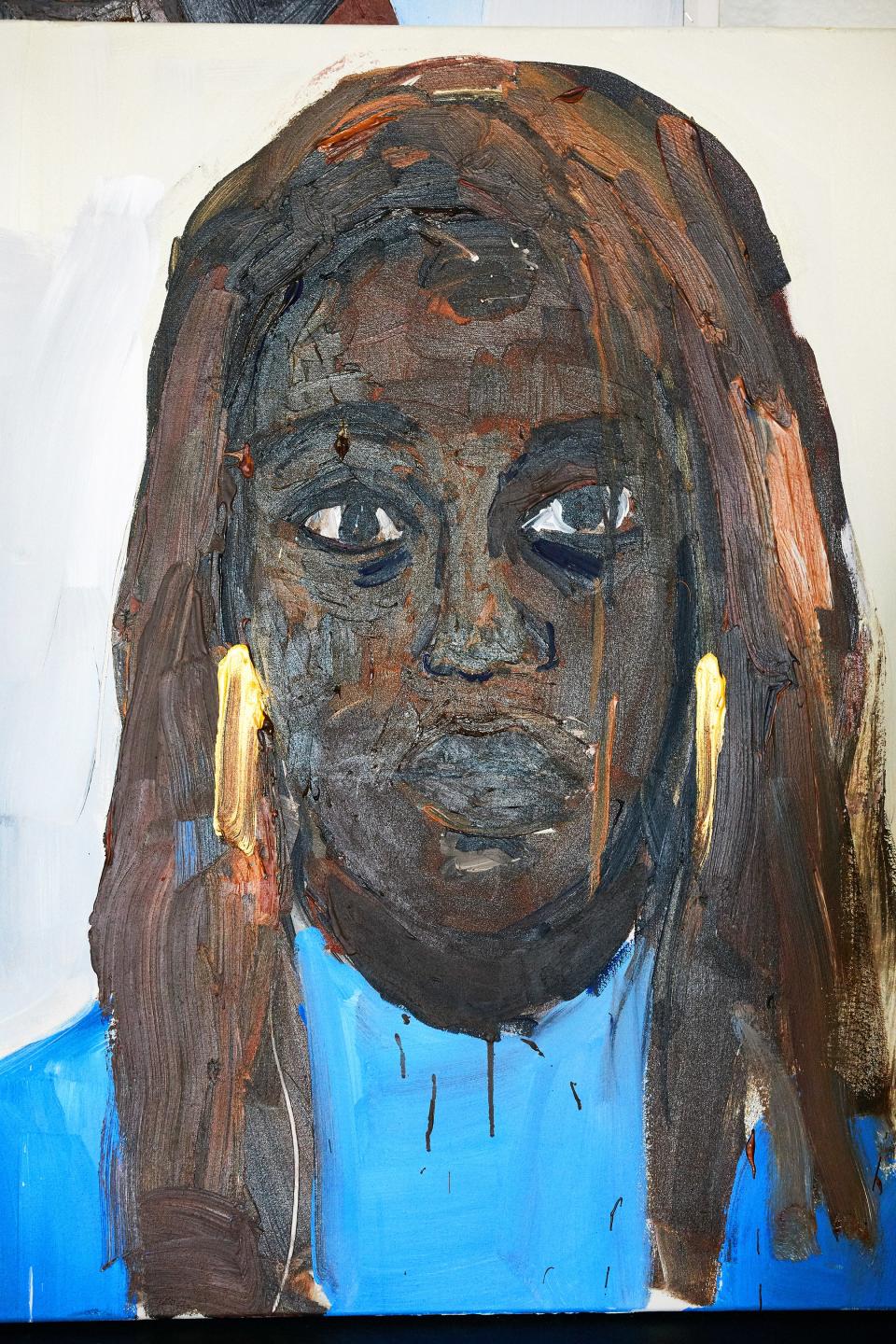


This recent flurry of interest and activity is all a far cry from Taylor's scene when I was first exposed to him back in 2004. It was around the time of his first solo show at Katie Brennan's Sister gallery in L.A.'s Chinatown. Taylor was living nearby, carousing around the clock with artist-gallerist Joel Mesler, who went on to show Taylor in both L.A. and New York. “There were about a half-dozen of us all living and working together,” Mesler says, referring to a crowd that included artists Phil Wagner and Mario Correa. “We had a recording studio above [artist Jorge Pardo's legendary] Mountain Bar. Henry used to come in when we were jamming, grab the mic, and just start screaming,” recalls Mesler. “I'd keep the reel-to-reel rolling every night, then edit in the morning.”
Back then, Taylor would apply paint to any surface he could find: shoebox lids, cigarette packs, lampshades, even a suitcase or two. His fluid interpretations of what constituted a canvas became a trademark, making him known as some kind of modern-day Gauguin or Toulouse-Lautrec. In retrospect, he was chronicling the nuances of what many now consider a watershed L.A. art-historical moment. The paintings were raw and ached with immediacy. I remember them making me feel like more than just a viewer—I felt like a witness to the original event. Adding to the visceral quality of Taylor's work was the ever present possibility that the artist's infectious howl could be heard echoing through the neighborhood's chintzy courtyards.
At the time, Taylor was already about 45, and I remember thinking it might be a little bit late to lump him in with all the other hot young kids being churned out of L.A.'s burgeoning art-school machine. But since then, Taylor's name has risen every bit as high as, if not higher than, the others in a crop that includes Laura Owens, Jonas Wood, Jorge Pardo, and Pae White.

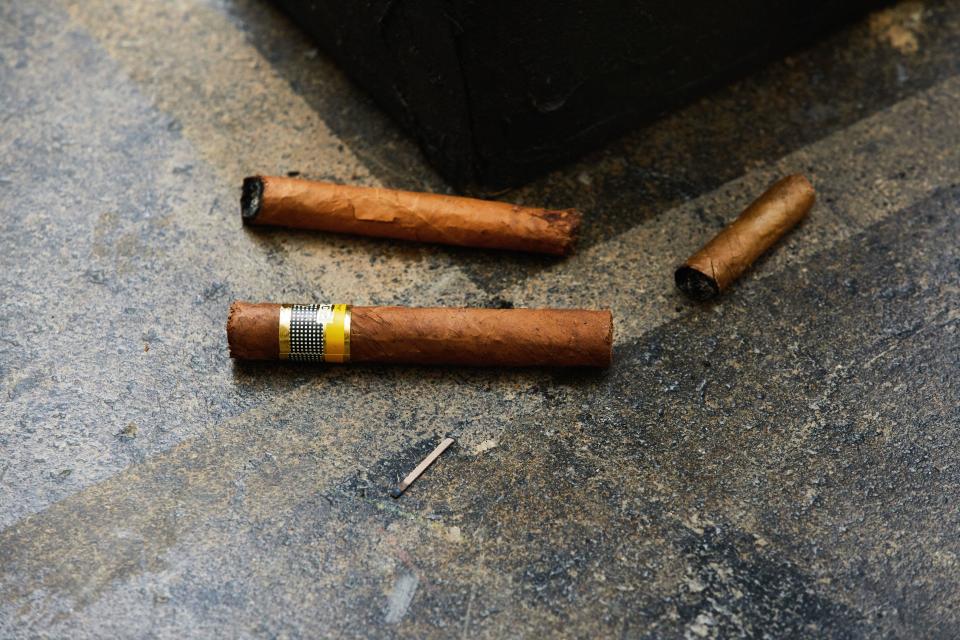
Back then, Taylor's mentor and teacher James Jarvaise encouraged the not-so-young Henry to develop a signature palette. Taylor looked to masters like Philip Guston, Cy Twombly, Jean Dubuffet, and Jacob Lawrence for inspiration—and his vibrant color has undoubtedly become part of his renown. In the end, however, I would argue that it's Taylor's long and tumultuous journey that gives his art such gravitas, rather than any one technique or art-historical reference. “His life experience has been so vast and so emotional, he has so much empathy, and that's why the work comes across so powerfully,” notes Blum & Poe's Jeff Poe. “And Henry is able to translate those feelings onto the person he's painting. It could be somebody in the room with him, a memory, a family member… Whatever the case, it's the empathy that comes across, because you can feel it. It's not like you're looking at something, you're feeling something, and that's what makes Henry so successful.”
To further illustrate his point, Poe cites a painting clearly seared into his frontal lobe: A Happy Day for Us, included in the 2017 Whitney Biennial. The nearly five-by-seven-foot piece is a pastoral of sorts, with trees that seem to fracture abruptly in the middle ground of the composition while in the right foreground a young black boy and girl walk together, each carrying a small bouquet. The coup de grâce is a set of wings protruding from the boy's back. Are the duo brother and sister? Young lovers, perhaps? Angels? Or maybe (gut-wrenchingly so) martyrs?
Taylor's work, though predominantly figurative, has an almost nonchalant quality typically associated with abstraction; to achieve the effect, the artist offsets areas of intense detail with larger, broader, and flatter swaths of color. “It's completely bizarre,” remarks Poe. “A crazy, delicate balancing act.” Taylor puts it to me like this: “Sometimes you want to get it just right, but look—I'm not an illustrator. I remember, once, this drawing I did of my dad.” Taylor mimes a decisive, singular brushstroke. “And I was like, ‘That's Dad right there!’ There was a time when something that simple would've made me feel like I was cheating, like I didn't put enough work into a piece. These days, I'm trying to be looser. People talk about inspiration, but once you get in there, you got to be receptive. Something's going to happen. If I'm a chef and you go in my kitchen, your ass is gonna come out with something that tastes good!”
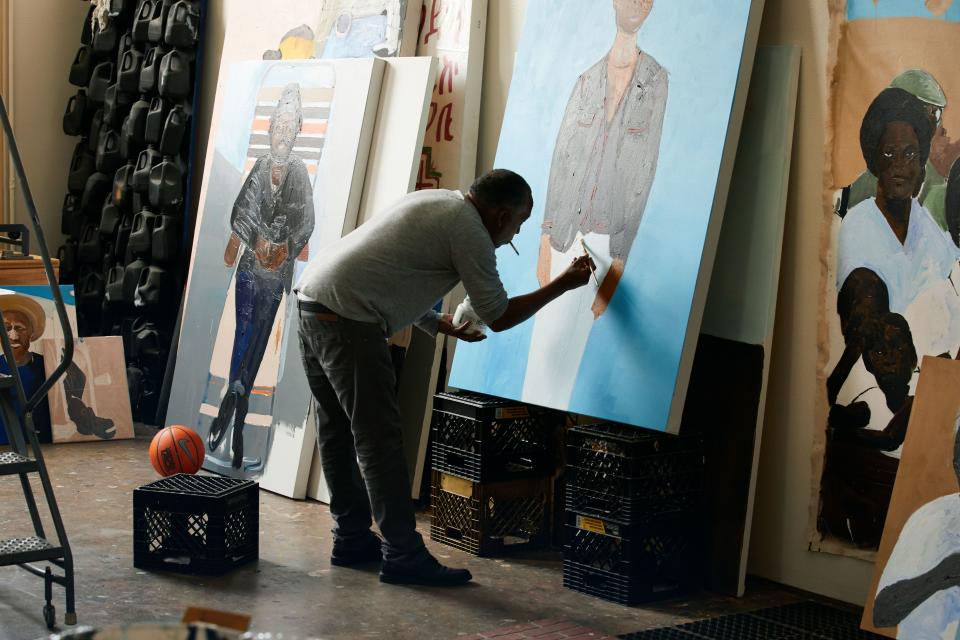
These days, Taylor moves between his house in L.A.'s West Adams neighborhood and his downtown studio. When he's not showing, he likes to travel, and he keeps a map of the world tacked up in his garage. Last spring, following a show in Tokyo, Taylor took a trip to Cambodia with the artist Sano, then went on to Vietnam by himself. Given the steadily increasing demands of life back home, the traveling creates space that Taylor packs by sketching compulsively. Oftentimes, the ministrations become catalysts for future paintings. That said, it's clear Taylor still sometimes pines for the bad good old days of yore. “I used to just be pulling shit in off the streets,” he says. “Scrap wood, all kinds of random shit. When I'm driving around, I still catch myself scanning over piles of trash! Sometimes you got to just drag stuff in and have it be there.” Taking stock of his current, slightly less chaotic surroundings, he adds, “Honestly, sometimes I just feel like I got lucky.”
While it's true that everybody needs a little luck to make it, what matters most is what you do with that luck. And judging by the brimming racks at his studio, Taylor has enough in-progress canvases to fill most top-tier museums. “The work is like a huge marinade of empathy, love, spirit, and magic,” says his gallerist Tim Blum. “Henry begins a painting, he hangs on to a painting, he becomes afraid of releasing them. I mean, you almost have to wrestle them out of his hands all the way up to the moment of a show. He's in love with the paintings. He's in love with the people in them.”
Arty Nelson is an art, food, and television writer living in Los Angeles.
“Four Rooms” featuring Henry Taylor opens at Blum & Poe New York on September 12.
Look Book
The capital of Senegal is booming with development. But not even a skyline of cranes can interrupt its hypnotizing elegance and legendary chill. We took the season’s best printed and patterned high fashion and spent 72 hours capturing the vibe on the street.
![ABOU SARR | AGE 24 | OCCUPATION Model (Shirt [women’s] by Giorgio Armani / Pants, $728, by Bode / Boots, $1,150, by Bottega Veneta)](https://s.yimg.com/ny/api/res/1.2/CmMJ1j37vMHTLmxv8tgB7w--/YXBwaWQ9aGlnaGxhbmRlcjt3PTk2MDtoPTY0MA--/https://media.zenfs.com/en-US/homerun/gq_402/75d36e88ad973411131c3bc0a3474dd4)

